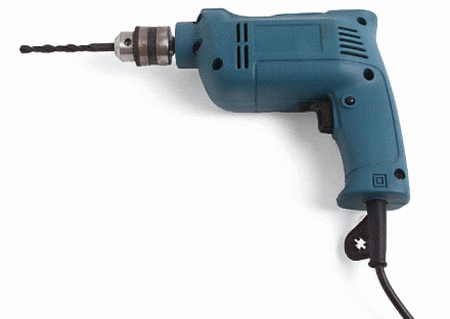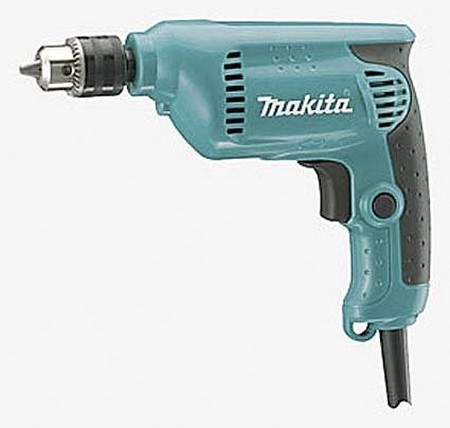An electric drill is basically a motor which drives a chuck through a series of gears. The motor shaft spins on bearings and turns a fan which blows air over the motor windings to keep them cool. The gears turn the high motor speed into a much lower chuck speed and so increases the available torque.
Nearly all electric drills these days are hammer drills, with a hammering action to get through tough masonry. The hammer action, which vibrates the drill bit backwards and forwards, can be turned off for straightforward rotary drilling in wood, metal and other materials. Some have a reversing function which makes them particularly useful as a powered screwdriver so that they can take screws out as well as putting them in. Electro-pneumatic drills have a more powerful hammer action and are generally more effective at getting through masonry though, because they are large and single-speed, are less effective for other types of drilling. This type of drill is quite expensive and if you need one only occasionally it would make sense to hire it.
A cordless drill is run from internal rechargeable batteries and needs no cable, which makes it very versatile. Cordless drills, on the whole, do not have the same power or maximum speed as mains-powered drills, but are useful for driving screws (all are reversible) and for making countersinks to save changing the bits in your main electric drill. They can also be used in places where it would be unsafe, difficult or impossible to take an extension lead for a normal electric drill. Recharging time varies from 2 hours to 16 hours; some have removable battery packs which is more convenient.
Most drills have a chuck capacity of either l0mm or 13mm. Some chucks are deliberately made so that very small drill bits (generally 0.5mm or less) cannot be gripped. Drills with larger chucks often have a more powerful motor though this is not always the case.
Electro-pneumatic drills do not have a normal chuck – they have a tool holder which takes special (and expensive) drill bits called SDS or SDS +. When using electro-pneumatic drills for ordinary drilling with the hammer action turned off, you need to fit a special chuck adapter which enables you to fit a suitable chuck and drill bit.
Manufacturers often advertise the power of their drills in watts input. Unfortunately this stated power is not always a guide to how much power one gets out of a drill. It is often a good deal less – up to40 per cent in some cases. The difference between the input and output is lost as heat, which is why a drill needs a fan to keep the motor cool.
With most drills, the drill will slow down as you press harder on it. Although drilling more slowly, the drill is actually working harder – up to a point, after which it will stop altogether. If run for too long like this, there is a danger of the drill burning out.
Some more expensive drills have two additional features to control the power. Constant speed control detects how hard the drill is working and increases the power as the load increases, so the speed is kept more or less constant. This is useful for deep holes where the drill would normally slow down as it went it. Variable torque limiting measures the twisting force (torque) at the chuck and switches the drill off when a certain level is reached useful when using the drill for screwdriving.

